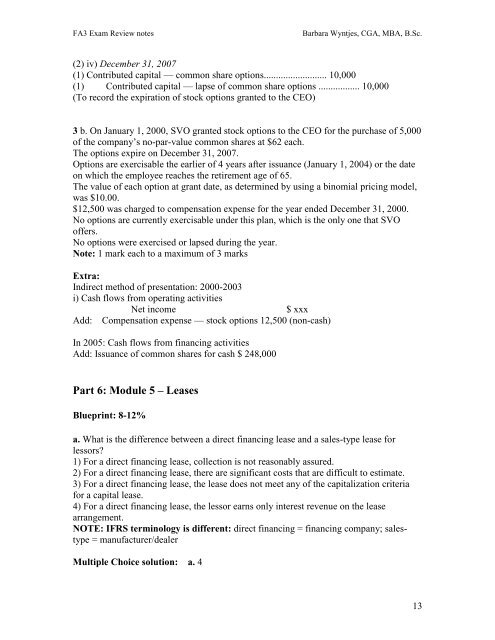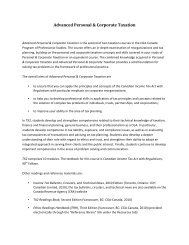Financial Accounting: Liabilities & Equities (FA3) Exam Review
Financial Accounting: Liabilities & Equities (FA3) Exam Review
Financial Accounting: Liabilities & Equities (FA3) Exam Review
You also want an ePaper? Increase the reach of your titles
YUMPU automatically turns print PDFs into web optimized ePapers that Google loves.
<strong>FA3</strong> <strong>Exam</strong> <strong>Review</strong> notes Barbara Wyntjes, CGA, MBA, B.Sc.<br />
(2) iv) December 31, 2007<br />
(1) Contributed capital — common share options.......................... 10,000<br />
(1) Contributed capital — lapse of common share options ................. 10,000<br />
(To record the expiration of stock options granted to the CEO)<br />
3 b. On January 1, 2000, SVO granted stock options to the CEO for the purchase of 5,000<br />
of the company’s no-par-value common shares at $62 each.<br />
The options expire on December 31, 2007.<br />
Options are exercisable the earlier of 4 years after issuance (January 1, 2004) or the date<br />
on which the employee reaches the retirement age of 65.<br />
The value of each option at grant date, as determined by using a binomial pricing model,<br />
was $10.00.<br />
$12,500 was charged to compensation expense for the year ended December 31, 2000.<br />
No options are currently exercisable under this plan, which is the only one that SVO<br />
offers.<br />
No options were exercised or lapsed during the year.<br />
Note: 1 mark each to a maximum of 3 marks<br />
Extra:<br />
Indirect method of presentation: 2000-2003<br />
i) Cash flows from operating activities<br />
Net income $ xxx<br />
Add: Compensation expense — stock options 12,500 (non-cash)<br />
In 2005: Cash flows from financing activities<br />
Add: Issuance of common shares for cash $ 248,000<br />
Part 6: Module 5 – Leases<br />
Blueprint: 8-12%<br />
a. What is the difference between a direct financing lease and a sales-type lease for<br />
lessors?<br />
1) For a direct financing lease, collection is not reasonably assured.<br />
2) For a direct financing lease, there are significant costs that are difficult to estimate.<br />
3) For a direct financing lease, the lease does not meet any of the capitalization criteria<br />
for a capital lease.<br />
4) For a direct financing lease, the lessor earns only interest revenue on the lease<br />
arrangement.<br />
NOTE: IFRS terminology is different: direct financing = financing company; salestype<br />
= manufacturer/dealer<br />
Multiple Choice solution: a. 4<br />
13






